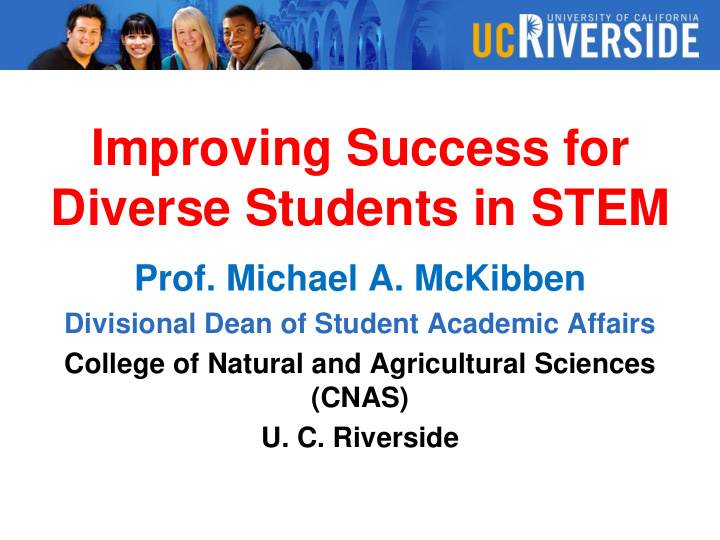



Improving Success for Diverse Students in STEM Prof. Michael A. McKibben Divisional Dean of Student Academic Affairs College of Natural and Agricultural Sciences (CNAS) U. C. Riverside
UCR is unique among UC campuses in its equity of campus graduation rates 6-Year Graduation Rates by Socio-Economic Status and Race-Ethnicity, 2006 Cohort Source: UCR Strategic Academic Research and Analysis (2013)
However, in STEM majors retention of freshmen is lower for under-represented students Second-Year Retention by College and Hispanic Ethnicity, 2006-2011 90.0 80.3 79.1 78.7 80.0 76.4 75.0 74.0 73.6 72.1 70.2 70.2 68.9 Perecentage (%) 68.0 70.0 60.0 56.3 55.5 53.5 52.4 51.0 50.3 50.0 48.7 48.0 50.0 46.6 45.9 44.7 40.0 30.0 2006 2007 2008 2009 2010 2011 UCR Overall CHASS - Humanities, Arts & Soc Sci (Hispanic) CNAS - Natural & Ag Sci (Hispanic) BCOE - Engineering (Hispanic) Source: UCR Strategic Academic Research and Analysis (2014)
Student Success Initiatives For this reason, the Science college (CNAS) has focused many of its academic interventions at the lower division (freshmen, sophomores). To create effective interventions, we must understand the demographics of our freshmen and the challenges that they face in finishing STEM majors.
Demographics of the Science College at UCR CNAS Freshmen Ethnicity 2014 AMERICAN AFRICAN AMERICAN/BLACK INDIAN/ALASKAN NATIVE WHITE UNKNOWN NON-RESIDENT ALIEN MULTI-RACIAL ASIAN HISPANIC/LATINO HAWAIIAN/PACIFIC ISLANDER CNAS is the most diverse Science college in the UC system
Demographics of the Science College at UCR
Socio-Economic Challenges Low-income – many need to work part-time, summer session is too expensive First-generation – have no role models at home for guidance on being a science student and STEM professional Under-represented – see few in the STEM faculty and professions who look like them, making it harder to visualize their career opportunities
Academic Challenges They are away from home for the first time, with many new distractions. Their new peer group at UC is much more competitive than their High School peers. The quantitative skills needed to master STEM subjects require intense study time (2 hours outside of class for every hour in class): 16 units + 32 hours = 48 hours/week!
Intervention Strategies in CNAS Summer Bridge Math Preparation before UC matriculation - but not everyone can afford it. Learning Communities – create a social and academic support group to help new Freshmen transition to college. Early Research Engagement – expose them to the excitement of scientific methods and discovery as early as possible. Early Career Exploration and Mentoring by near-peers and alumni – role models.
First-year Learning Communities - facilitating the critical transition Place incoming Freshmen with similar math placements and majors into cohorts of 24 students. Take the same math and core science courses all year long as a cohort. Peer tutoring in math and science courses throughout their first year. Faculty mentoring and academic advising seminars in Fall.
Faculty mentoring on science and careers – learning that faculty are approachable, and focused on research as well as teaching Academic advising on curriculum planning – learning to trust their advisor, so they are more willing to go to them when they need help
First-year research engagement Biology 20: The Dynamic Genome (dna extraction and gene sequencing) – for Life science majors Chemistry 95: Explorations in Molecular Science (computer modeling and field sampling of atmospheric gases) – for Physical/Mathematical science majors Hands-on, active learning laboratory research (24 students/class) conducted alongside their large introductory Biology and Chemistry courses (300-600 students/class).
Focuses on teamwork, group problem-solving, public speaking and professional development
Sophomore Career Mentoring Alumni and Peers
Impact of the Learning Communities – some background facts Nationally, the graduation rates in STEM majors at four-year US institutions are: 25% after 4 years 40% after 5 years More than half of aspiring STEM students do not graduate in STEM.
Average First Term GPAs for the Test Group, Disaggregated, 07F-13F 3.4 3.222 3.203 3.190 3.144 3.134 3.2 3.072 3.074 2.938 3.0 2.750 Average Fall GPA 2.768 2.8 2.881 2.796 2.756 2.744 2.6 2.633 2.579 2.608 2.527 2.480 2.4 2.406 2.417 2.2 2.0 07F 08F 09F 10F 11F 12F 13F LC Completers WL Non-Completers
CNAS Retention (FR to SO) for the Test Group, Disaggregated, 07F-13F 100.0% 97.2% 95.6% 95.3% 95.1% 96.2% 94.6% 94.2% 95.0% 95.1% 92.9% 93.3% 90.0% 89.9% 89.1% 92.0% 90.7% 90.1% 89.2% 87.1% 85.6% 85.0% 84.2% 84.4% 82.5% 80.0% 75.0% 70.0% 65.0% 60.0% 55.0% 07F 08F 09F 10F 11F 12F 13F LC Completers Waitlist Non-Completers
4 Year CNAS Grad Rates for the Test Group, Disaggregated, 07F-10F 70.0% 60.0% 53.3% 50.0% 52.0% 51.4% 40.0% 41.5% 34.1% 32.8% 30.0% 30.4% US Avg 20.0% 22.0% 17.6% 16.7% 10.0% 13.1% 13.0% 0.0% 07F 08F 09F 10F 4 Yr LC Completers 4 Yr LC WL 4 YR LC Non-Completers Doubling of 4-year graduation rates over the national average
5 Year CNAS Grad Rates for the Test Group, Disaggregated, 07F-10F 70.0% 64.2% 65.0% 60.0% 58.7% 56.3% 50.0% US Avg 43.0% 40.0% 45.5% 34.4% 33.3% 30.0% 26.7% 26.7% 27.4% 20.0% 14.4% 10.0% 0.0% 07F 08F 09F 10F 5 Yr LC Completers 5 Yr LC WL 5 YR LC Non-Completers
6 Year CNAS Grad Rates for the Test Group, Disaggregated, 07F-09F 70.0% 65.7% 65.7% 60.0% 58.5% 50.0% 46.6% 43.0% 40.0% 35.6% 30.0% 28.0% 27.8% 26.7% 20.0% 10.0% 0.0% 07F 08F 09F 6 Yr LC Completers 6 Yr LC WL 6 YR LC Non-Completers These 6-year rates in CNAS LCs are the same as the campus rates!
Federal grant support of CNAS’ student success programs: 2013: National Science Foundation awarded CNAS $2.0 M for 5 years to expand its freshman learning community program. 2014: Howard Hughes Medical Institute awarded CNAS $2.4 M for 5 years to support early research and career engagements for its freshmen and sophomores.
Recommend
More recommend